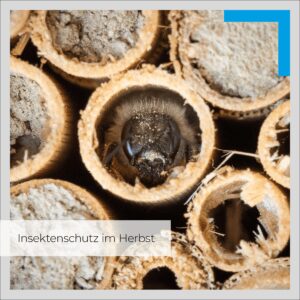

NEWS: Colourful flower beds, flower strips and wildflower meadows, in spring and summer many people now contribute to insect protection. But even in autumn there is still a lot you can do to protect insects and help them overwinter.
From October onwards, the activity of insects decreases, but on sunny days many are still looking for food. In the garden, for example, ivy blossoms are an important source of food that lasts into the winter. But there are also possibilities on the balcony; until the end of November, chrysanthemums are still a food source for bees, butterflies and other insects. Another food source in the garden or on the balcony are late-flowering stonecrops, such as the Siebold stonecrop, variants of the tall stonecrop and the yellow-flowering Tripmadam stonecrop or the marigold.
But other plants that no longer provide food are also important for the overwintering of insects. Some moths, for example, overwinter as pupae and attach themselves to various plants. Therefore, meadows should no longer be mown in autumn and perennials and grasses should not be cut until spring. The majority of butterflies overwinter as caterpillars in the ground or under tree bark. To support them, leaves should be left in the garden in autumn and plants such as horseshoe clover, willows and wild herbs should be planted as food sources. Some bees hibernate in plant stems and hollow branches, so old wood, plant stems and above-ground cavities should be preserved throughout the winter and perennials and woody plants should not be pruned until spring. You can also support the bees with insect hotels, dry stone walls, herb spirals and rock piles.
By protecting some insects, we can also help ourselves. For example, beetles overwinter as larvae in the soil. When they hatch in spring, they feed on snails, worms and caterpillars. We can support them by keeping the soil healthy and rich in humus. Lacewings like to overwinter in piles of leaves and brushwood. When they awaken in spring, they feed on aphids and the like.
Overall, it can be said that the more untidy the better. Leaves, tall grass, dead branches and much more provide insects with shelter in winter. But insects can also hibernate in the attic or in sheds. Some species of butterflies, in particular, prefer such frost-protected places.
You can also make provisions for the end of winter. As many early-flowering plants as possible should be planted in the garden so that new food sources are available as early as possible. These include winter bulbs, crocuses and snowflakes.
In this way, everyone can contribute something to better nature conservation. In larger projects, it is often necessary to intervene in nature. Our team from the "Environment and Geotechnics" business unit is at your side as a competent partner and helps you to minimise such interventions or to carry them out in an environmentally compatible manner as early as the planning phase.
Engineering for a better tomorrow.
#Biodiversity #Insect protection #mullandpartner #engineeringforabettertomorrow

